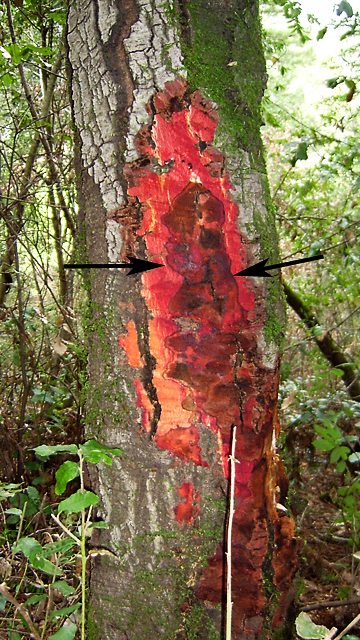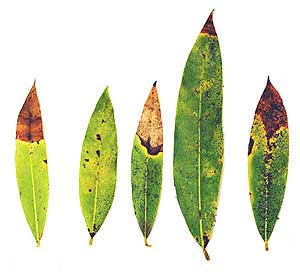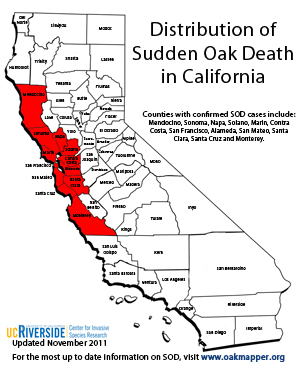Sudden Oak Death (Phytophthora ramorum)
The Situation: Phytophthora ramorum is one of several species of related fungus-like water molds (oomycetes) that are pathogenic to plants. Another member of this group, P. infestans, is notable as the cause of the potato blight epidemics in Europe in the mid-1800s. More recently, P. ramorum has emerged as a major threat to California woodlands. This pathogen is the causal agent of Sudden Oak Death, which is characterized by the development of seeping cankers on the trunk, foliage dieback, and eventual death of infected trees. The first cases of Sudden Oak Death were reported in northern California in the mid 1990s, and the pathogen was first isolated in 2000 from cankers on dying trees. Since then P. ramorum has spread throughout the Northern California coast range into Oregon. Although there is no known cure, a preventative chemical treatment has shown promise in slowing spread of the pathogen. Ultimately, effective management of Sudden Oak Death requires early detection, quarantine, removal and destruction of infected plant material.
Damage: P. ramorum has a wide host range, with more than 45 California tree and shrub species capable of being infected by this pathogen. However, host plants differ in their relative susceptibility to infection. Some hosts, such as tanoak (Lithocarpus densiforus) and coast live oak (Quercus agrifolia), exhibit strong systemic infection and high mortality rates. In the most susceptible species complete girdling of the plant and rapid browning of the foliage can occur in as little as one year. Others species, most notably California bay laurel (Umbellularia californica), manifest only foliar lesions and mild twig dieback. These “foliar hosts” tolerate infection with low mortality making them epidemiologically important pathogen sources for more susceptible species. Mixed evergreen-bay-arbutus, Tanoak-Douglas fir, and Coast Redwood are the three major forests types most affected by Sudden Oak Death. It is estimated that the Sudden Oak Death has killed over 1 million trees in 12 coastal counties of central and northern California.
California forests are essential for water filtration, nutrient cycling, carbon storage, soil formation, and erosion prevention. Oak woodlands also make up a large part of California’s biodiversity with at least 300 vertebrate terrestrial species, 5000 arthropod species, and 1100 native vascular plant species. P. ramorum invasion poses a major threat to plant and wildlife community composition, food resources, and ecosystem functioning. Impacted forests are also expected to have more frequent and intense fires due to rapid buildup of fuels that has resulted from trees killed by Sudden Oak Death. The precise economic impact of Sudden Oak Death is not known, but it is estimated to be in the tens of millions of dollars from loss and quarantine of nursery crops that can spread Sudden Oak Death, decrease in property values, cost of monitoring and eradication, and losses of recreational, aesthetic, and cultural value.
Distribution: The origin of P. ramorum is not known definitively, but it is believed to have been introduced from Asia and proliferated in plant nurseries. The first cases of Sudden Oak Death were reported in Marin County, CA and Santa Cruz County, CA in 1994 in tanoak and 1995 in coast live oak. Since then it has spread throughout much of the Northern California coast range mountains as far south as Big Sur and north into Oregon. Although P. ramorum is only reported to exist in California and Oregon forests, it has the potential to infect susceptible oak species on the east coast, including the northern pin oak (Quercus palustris) and northern red oak (Quercus rubra).
P. ramorum’s mode of transmission is not clearly defined, but there is no evidence that it is transmitted by insects. Infected plants produce spores that are thought to be dispersed by wind and rain splash. There is also some concern that boot and bike traffic in public areas may be play a role in the movement of more resistant stages of the pathogen.
Given its ability to infect a wide range of host plants, nurseries have likely played an important role in the spread of P. ramorum. Infected nursery material has been found in both the United States and Canada. Moreover, a second mating type of P. ramorum has been indentified in nurseries throughout much of Europe, and has made the jump into forests in the U.K. and the Netherlands. This pathogen is believed to be capable of spreading to other northern areas or some southern coastal Atlantic/Mediterranean areas in Europe due to its preference for wet climates and mild temperatures.
Research: Since 2000, California and the U.S. federal government have committed millions of dollars towards research and monitoring of P. ramorum. Researchers at the University of California and other institutions have been investigating several aspects of this pathogen and disease. Some of this work includes improvement of molecular detection techniques, and genetic characterization of the pathogen to pinpoint its origin. Several ongoing projects are also studying the ecological impact of this pathogen on future forest dynamics, wildlife assemblages, and even Lyme disease severity. Finally, researchers are studying the efficacy of a systemic fungicides as a prophylactic control measures.
Center for Invasive Species Research, University of California Riverside
Text provided by Matt Daugherty (and Kim Hung) Assistant Extension Specialist at University of California
Images courtesy of Jennifer L. Parke (Oak) and D. Schmidt (Leaves)
Matt Daugherty, Assistant Extension Specialist
matt.daugherty@ucr.edu
Personal Website



